RV Hot Water Heater Troubleshooting: 8 Easy Solving for Heat Water
Executing an RV hot water heater troubleshooting can be tricky, considering the numerous issues that can cause its malfunction. Luckily there are ways to depend on, including DIY approaches, to help you rectify before it results in other mechanical problems.
We shall go through 8 water heater issues, analyzing each to identify the best solution. Read on to also discover what to consider when buying RV heaters and the maintenance tips for the system. Let’s get started!
Table of Contents
How Can You Access Hot Water in Your RV?
Vehicle water heaters run on propane gas, while some use an electric heating element. Usually, either fuel can work efficiently, but the combo is better.

Your ability to consistently get hot water depends on the following:
- Whether the RV has a water heater tank.
- The state of the hydraulic system and its respective fuel (propane or diesel).
Having all systems running ensures you get your tank’s worth of supply. However, mishaps arising from the system’s wear and tear can cause technical errors. Therefore, always monitor your water heater closely, similar to going for a vehicle to service.
How Long Does Hot Water Last in an RV
The longevity of RV hot water is dependent on various factors, which include:
- The capacity of the water tanks.
- Hot water is mostly used for showering or washing dishes in chilly evenings or seasons.
The size of the tank does play a more significant role. A related factor is the rate at which respective gadgets like showerheads work. A normal showerhead type will release between 1.5 to 3 liters in a minute. Therefore, you can always calculate how long the remaining water capacity can serve you.
RV Hot Water Economy Tips
Like any other system, there are loopholes to ensure you enjoy quality showers at home.
- Getting a shower gadget with a relief valve. When water heater bypass valves, you save water in between wash-ups. The simple tech helps avoid unnecessary cold showers due to insufficient pressure.
- Also, use warm water when the tank capacity is small.
This video show’s you the heater’s dynamics and related malfunctions.
RV Hot Water Heater Troubleshooting Guide: 8 Common Problems and Their Solutions
As mentioned, different factors affect your heater, primarily because of the mechanical system’s failure. Below is a complete review of these issues and the RV water heater troubleshooting tips. Let’s dive into the details!
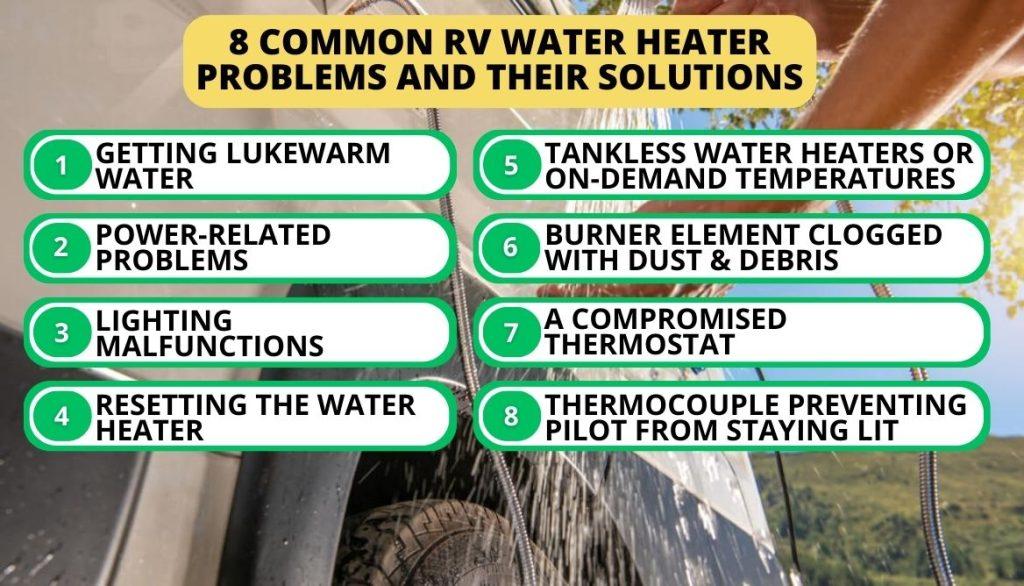
1. Getting Lukewarm Water
You’ll be frustrated if you get lower temperatures than anticipated, especially during the cold season typically because:
- Hot and cold water mix outside the storage.
- A small hot water tank size.
Here are potential solutions you can put in place:
- Limit the time you’ll use hot water if you have a small water tank size.
- Rectify any piping issues to avoid hot and cold water mixing.
- Modifying the settings to hot water, as you can accidentally switch the shower slider or button to warm instead.
- Confirm if your showerhead is running properly, as water blockage can affect the flow.
Understanding how your shower works is important, as modern versions might have complex setups.
2. Power-Related Problems
Power failures are common if your heater uses propane, electricity, or a combination. If you’re having a power issue, here are some troubleshooting tactics you can use:
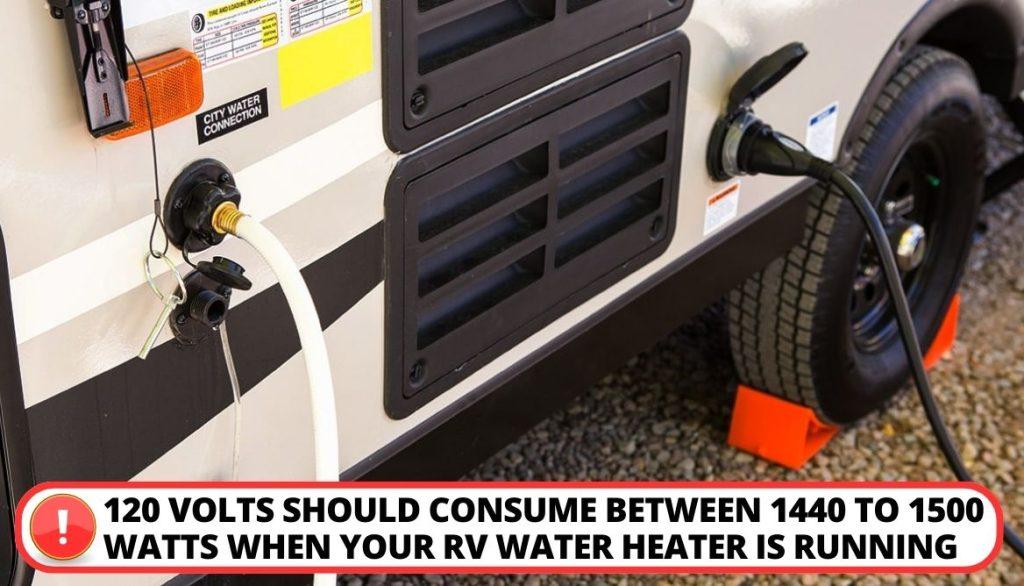
To ensure you have a consistent power supply, start by:
- Confirming that you’ve turned on the campground pedestal in your water heater for consistent power input.
- Check and fix the 120-volt panel breaker. 120 volts should consume between 1440 to 1500 Watts when your RV water heater is running.
Multimeter Usage
Use a multimeter to check the functionality of your water heater and confirm everything is working appropriately. Here is an easy way of using your multimeter if it’s your first time handling RV water heaters:
- Firstly, ensure the 120-volt mechanism is off, and your device is set to ohms. Slide your leads beneath the bolt heads attached to the heating element’s metal plates.
- Your ohms settings should be between 9.6 to 10 ohms. If the readings exceed 10 ohms, you should replace the system and consult an expert for such mechanical repairs.
3. Lighting Malfunctions
The ignition system can also cause issues with RV hot water heaters. This is primarily due to compromised ignition or a faulty flame, leading to inconsistent power supply. Below are different ways you can solve your RV water heater power malfunctions:
Various reasons can cause lighting issues. Here are some RV water heater troubleshooting methods to fix such problems:
- Since propane tanks are mostly affected, you can start by checking the state of the RV’s 12- Volt battery and confirm it’s in the right working condition.
- You can check if there’s enough propane fuel in the tank.
- A persistent RV water heater lighting issue means the gas valve, chamber, and flame components are faulty.
- Remove the bypass valve and clean it yourself, or seek the assistance of a professional who can also resolve any chamber and flame issues.
4. Resetting the Water Heater
Various factors lead to a switch in respective RV water heater settings. Depending on your tank or tankless type, the ECO and hot water might switch due to the following:

- A change in water pressure because of less water.
- An automatic switch can be caused by overheating.
Different RVs have varying tank designs, which will determine how to configure your hot water settings. For example:
- Dometic and Atwood tank styles and various tankless options require you to switch off and on their system to set back your circuit board volt specifications.
- You can configure hot water settings on Suburban tankless types and other similar versions by pressing the reset dial on the setup’s exterior section.
Note: This problem can mean other secondary issues like a faulty thermostat, where tankless varieties need extra caution via decalcification. You should contact a qualified party before using the above reset methods.
5. Tankless Water Heaters or On-Demand Temperatures
Tankless heaters are similar to mini boiler mechanics, with their proper functionality depending on:
- The available volume of water flow.
- Rate of your usage.
Additionally, on-demand temperatures are easy to attain but may require opening the hot water faucet to allow the heater to switch on a certain volume. This will save the propane when the gallon flow reduces below the required limit.
Here’s how you can achieve great shower temperatures when using a tankless water heater:
- You can try mixing cold and hot water instead of tampering with your Faucet, especially if the 120 Fahrenheit temperature (max limit) isn’t enough.
Your tankless design might also have a thermostat that you can adjust to set your ideal water temperatures.
Also, click here to see a full troubleshooting guide.
6. Burner Element Clogged with Dust & Debris
Dust and debris are common in many systems. Despite a tankless heater having a cover, dust may still penetrate.
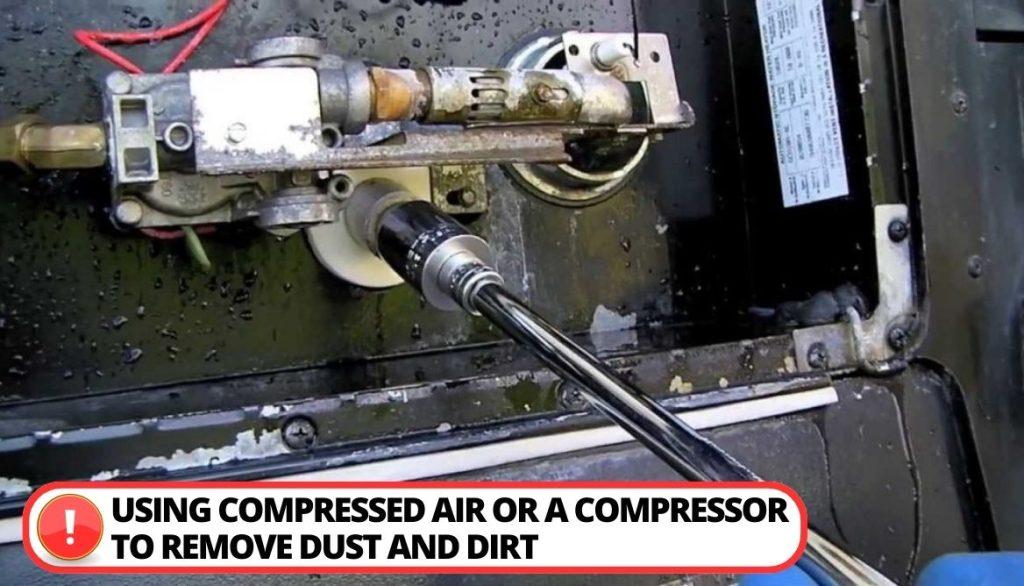
Considering the security mechanisms added, you’ll need to follow some steps to revert your RV’s water heater malfunction.
- Step 1: Ensure the water heater circuit breaker and any other heating element are off.
- Step 2: Extract the company covering that shields the burner.
- Step 3: Photograph the burner set up before disintegrating it from the manual gas valve.
- Step 4: Remove the combustion door, then slide the burner out seamlessly.
- Step 5: Use any preferred methods to spray off the dust. You can utilize a compressor or canned air for the best results.
- Step 6: Use the image to guide you in assembling the disintegrated parts, followed by turning the heater on and observing if there’s any improvement.
7. A Compromised Thermostat
A faulty thermostat can be tricky, resulting in inconsistent cold water heating. Your RV is most likely having this issue if you get hot water momentarily, then the system immediately reverts to cold water. Here are some possible solutions for dealing with a compromised thermostat.
Here is what you can do when getting cold water temperatures from your RV heater.
- Step 1: Ensure the electrical system is shut off to avoid complications when sorting out the thermostat.
- Step 2: Identify the thermostat compartment and remove the cover. You might need some insulation.
- Step 3: Use a multimeter to confirm there’s no charge stored in the thermostat.
- Step 4: Take a photo that you’ll use when assembling the gadget.
- Step 5: Locate the thermostat’s mounting bracket and carefully push it on one side. Follow by gently turning the gadget up. The bracket will be loosened, allowing you to remove the thermostat safely.
- Step 6: Carefully analyze the water heater device. Start by disconnecting any wires attached. Check for any signs of short-circuiting, notable by burned-out wires. Ensure you use new wires if you encounter these problems.
- Step 7: If the wiring is okay, you can re-install the thermostat in reverse order.
- Step 8: Continue to turn the system on after a proper attachment and confirm it is working properly.
- Step 9: Use the cover to seal the thermostat compartment if everything runs normally.
8. Thermocouple Preventing Pilot from Staying Lit
Old model Rv water heaters have their share of mishaps, a thermocouple failure being one of the main problems. Older varieties use a standing pilot light to maintain on-demand water temperature and can shut off unexpectedly.
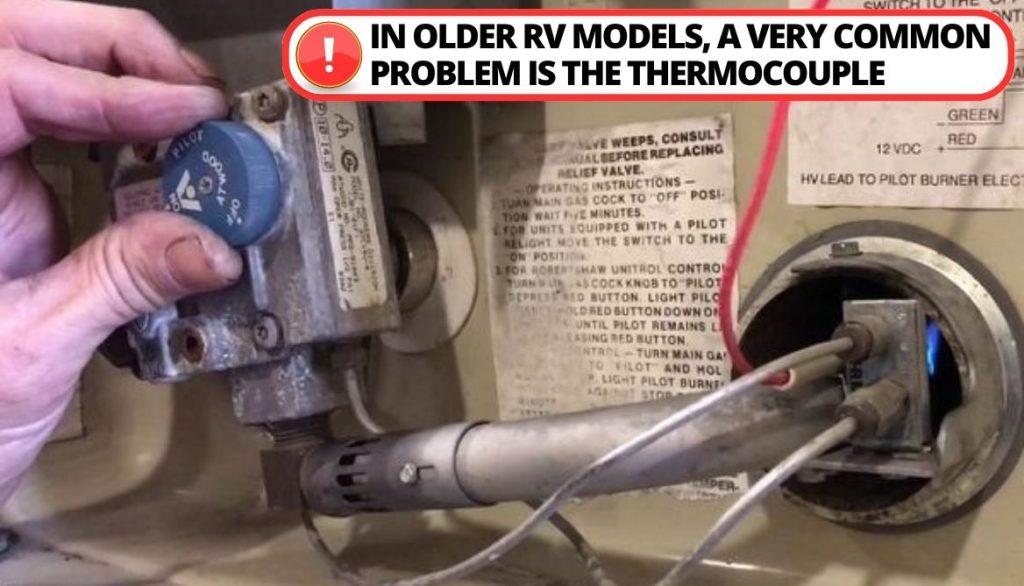
The first option can be switching the propane tank. Try other water troubleshooting tips, like eliminating the dust clog and allowing the pilot heating element to work efficiently.
Normally, you only need to sort a relight issue, and when the pilot still shuts off, follow the process below:
- Step 1: Access your pilot compartment, which can also require the removal of the entire panel.
- Step 2: Analyze the thermocouples state. If you’re new to its dynamics, it resembles a small metal probe with a single wire attached to its back.
- Step 3: Use cotton and a neutral cleaner to clean dust particles. This will help you see if there are damages like burns. You’ll need a replacement if you pinpoint burn scars.
- Step 4: Find the fasteners that join the tube and pilot light burner for necessary cleaning. You might need to remove the entire system if you can’t access the fasteners.
- Step 5: The cleaning process involves using neutral components like canned and compressed air or other useful tools.
- Step 6: Reassemble the pilot light and switch on the circuit and the propane tank supply.
Factors to Consider when Buying the Best Hot Water Heater for a Motorhome
Most individuals will only consider the price of a water heater when in the market for one. Here are features to consider when looking for the best water heater.
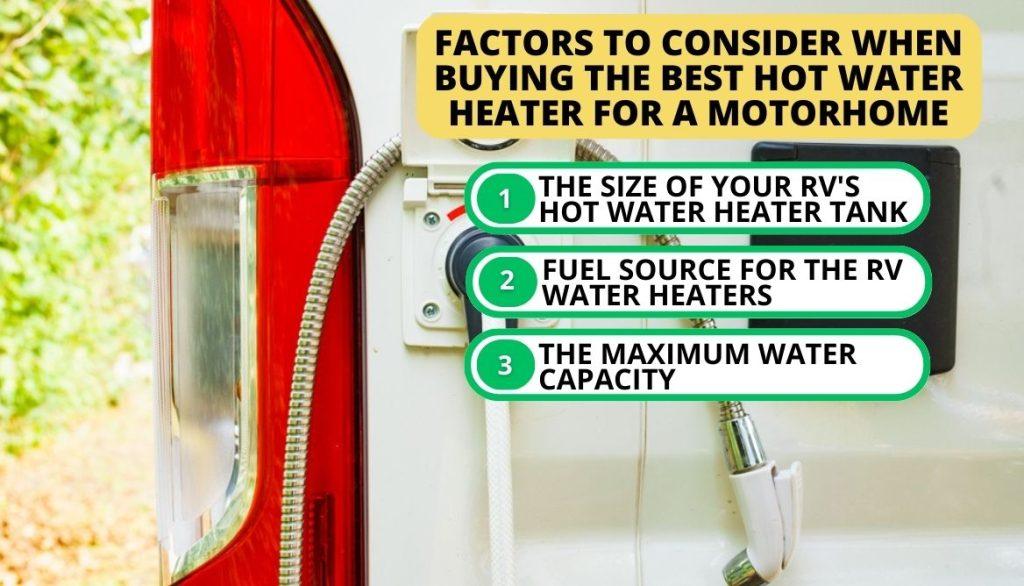
1. The Size of Your RV’s Hot Water Heater Tank
You should ensure the brand is compatible with the space inside your Motorhome. This is because some varieties are only suitable outside your RV.
2. Fuel Source for the RV Water Heaters
Motorhomes can use gas and electric water heater, which requires analyzing how you can conveniently refill /charge your RV water heater.
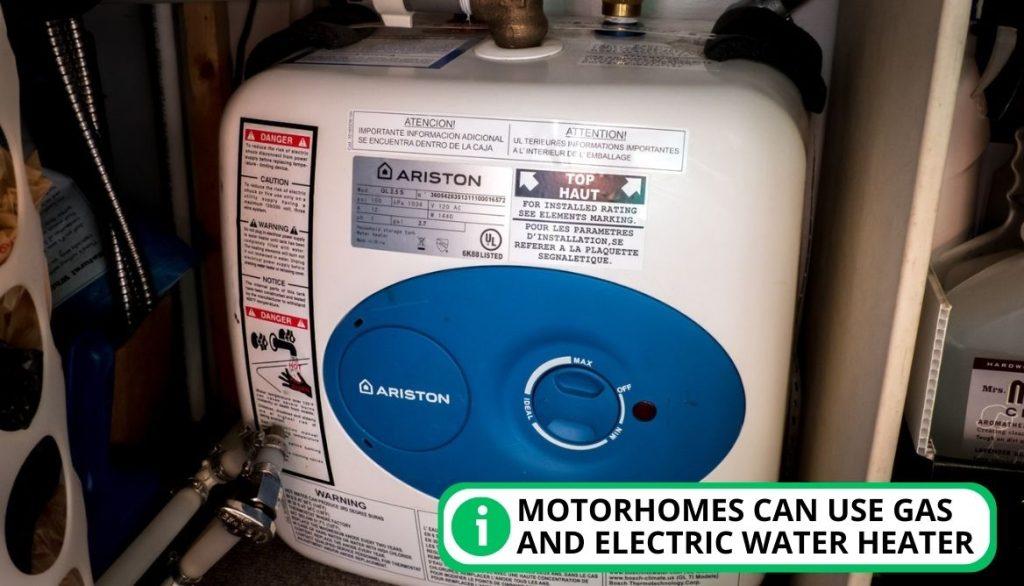
3. The Maximum Water Capacity
Evaluate the amount of hot water you’ll require regularly to select an appropriate size. A bigger model will cost more, but it’s a time saver if you have numerous users or need a large hot water supply.
Maintenance Tips for a Hot Tankless Water Heater
As mentioned, a tankless heater requires special maintenance mechanisms. Check out some of the tips you can use to correct tankless hot water heater issues.
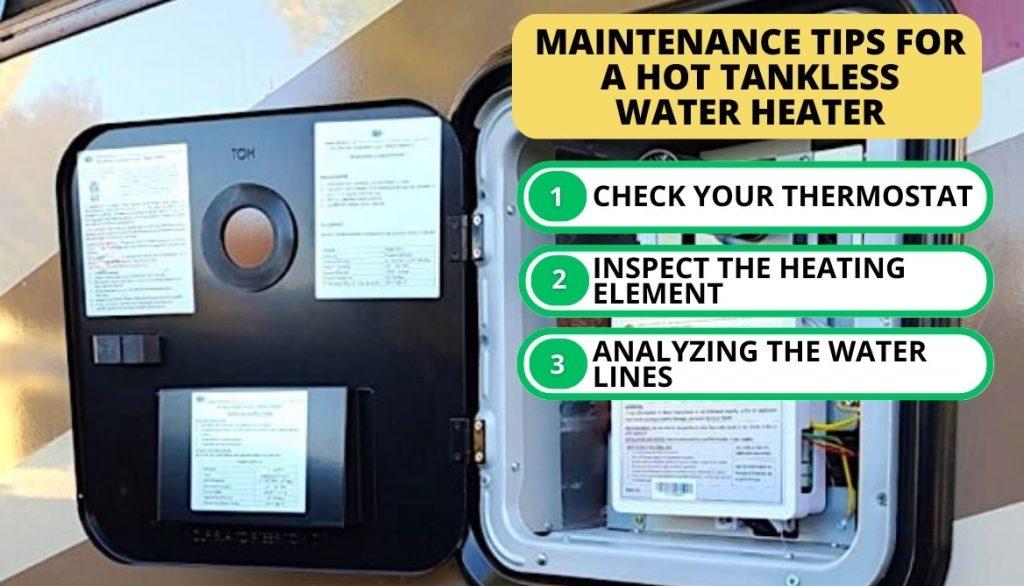
1. Check your Thermostat
Confirm the thermostat wiring system is securely connected. It is key to replace any damaged components, especially the burns on the gadget. Also, get expert help to execute the process, which ensures any other related malfunctions are worked on.
2. Inspect the Heating Element
Another crucial troubleshooting tip is regularly ensuring the heating element is clean:
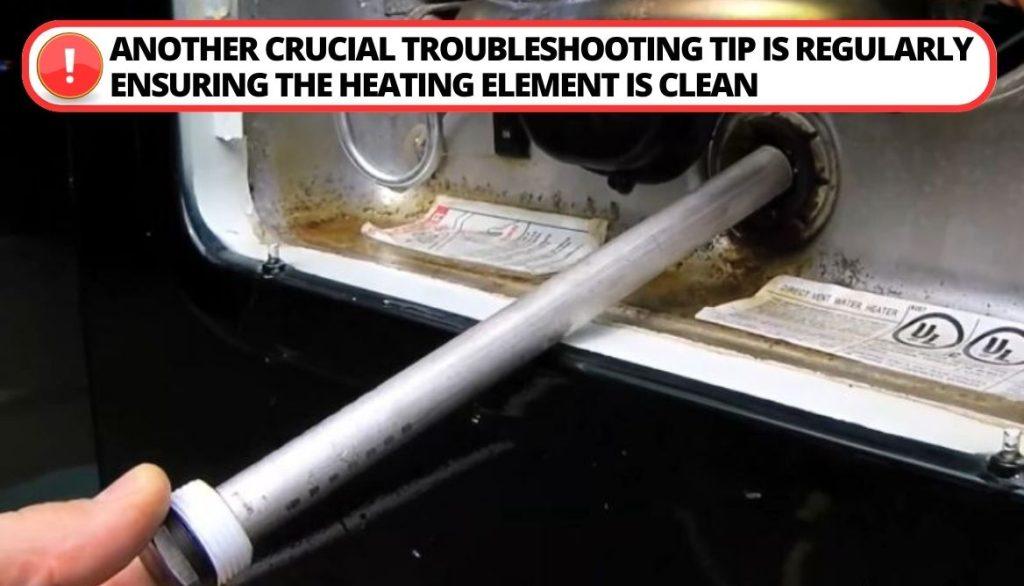
- The tech can collect dust and debris over time.
- Additionally, inspect the Rv’s water heater anode rod if your preferred brand has one.
3. Analyzing the Water Lines
Finally, check for clogging or leakages in the heater’s water lines. A great preventive measure includes flushing out any sediments using a vinegar solution.
Frequently Asked Questions
Why is the RV water heater not working?
RV water heaters might not work if there are issues with the thermostat, thermocouple, power shortages, and other electric water heater malfunctions.
What is the common problem with hot water heaters?
The common problem is water leaks and inconsistent power, which limits the heating to lukewarm.
Where is the reset button on the RV water heater?
The reset button is mainly a red button that is located near the thermostat underneath a detachable metal plate.
Why is my water heater not getting hot?
Getting hot water while there’s a tripped circuit breaker or a faulty fuse will result in lukewarm or cold water output.
What voltage is an RV water heater?
Rv’s water heater battery is a 12-volt variety.
Conclusion
That’s all we had regarding the major hot water problems, which can be a bother when planning a trip with your RV. Some of the issues discussed are common, resulting from natural factors like dust, while others, like thermostats and fuse malfunctions, require extra caution.
You can utilize the discussed troubleshooting techniques for faster solutions. Remember to consult an expert if you encounter a bigger issue or need clarification with the problem source.
So, have you faced any of the mentioned heating malfunctions? Comment below with the answer, and tell us the solution you used.
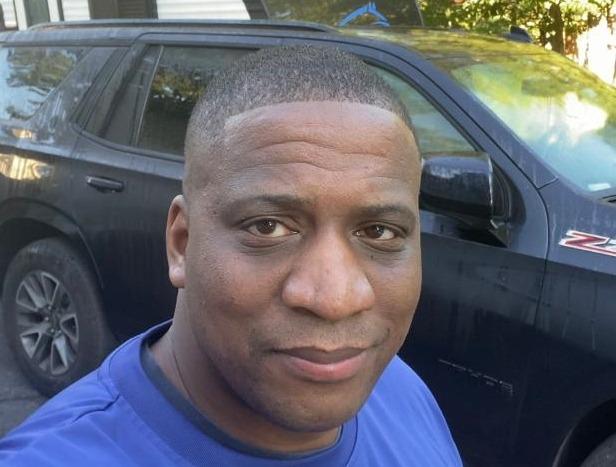
I`m a current Law Enforcement Officer working within the Counterterrorism Bureau in New York State. I have been Camping for over 20 years. My styles of camping include tent, car, truck, van, and RV travel trailer. I have a YouTube channel where I teach all types of camping with an entertaining method: https://youtube.com/@TheSmallsRVAdventures






